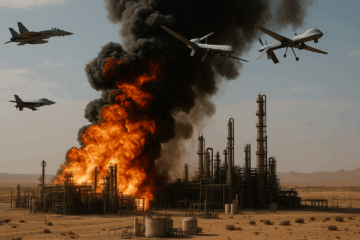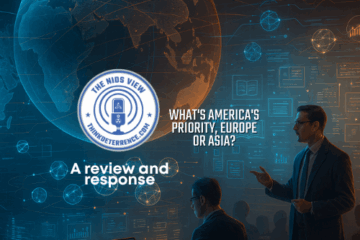The four years from 2025 promise to be a very difficult time for nuclear deterrence if the trends of the past decade and one-half since the completion of the New START treaty continue. As emphasized by the Nuclear Posture Review at the time, growing cooperation on nuclear matters between the US, China and Russia was anticipated to achieve three critical objectives: (1) continue the pursuit of global zero nuclear weapons; (2) continue the mutual cuts in nuclear weapons starting by the START treaty of 1991 and continued through the Moscow agreement of 2002, and (3) prevent any additional proliferation of nuclear weapons especially with respect to Iran including the eventual roll-back of the North Korean nuclear deployments.
Eight recent assessments of future prospects for strategic stability in light of growing nuclear dangers have been brought forward for consideration including (1) a Brookings Institute essay by Caitlyn Talmadge on the Biden and Trump approaches to nuclear deterrence; (2) Representative and Intelligence Chair Mike Turner’s nuclear and space related remarks at CSIS; (3) Joe Cirincione’s description of the Biden and Trump nuclear agenda’s as dangerously bad and worse, respectively; (4) Professor Wittmer’s complaint that everything Trump might do or has done on nuclear deterrence has accelerated the “arms race”; (5) Brad Robert’s top-notch look into the future about what the LLNL program director describes as “unwelcome” truths that must be faced; (6) Mark Schneider’s welcome assessment of what French President Macron is trying to do with extended nuclear deterrence in Europe and the related pitfalls; (7) Mathew Kroenig and Mark Massa review the value of ICBMs and particularly what is required for future ICBM related nuclear deterrence–and in their usual scholarly manner; and (8) commentary by Mike Albertson of LLNL and (9) Con Coughlin of Gatestone about what the US and its allies are facing over the next few decades in the nuclear arena and why meeting the deterrent challenge is both very interesting but also absolutely challenging. Coughlin’s top concern is the US non-confrontational policy with respect to Iran and the relative loss of credible US deterrent capability.
The Critics
Talmadge, Wittmer, and Cirincione portray former President Trump as some kind of nuclear Mad Hatter or Dr. Strangelove who will bring about nuclear Armageddon, although all three largely get recent nuclear deterrent history wrong. However, their narrative is common with Hollywood and reflected in both the new Oppenheimer film, as well as in Annie Jacobson book that describes current US nuclear deterrent strategy as “Mad” and immoral. Cirincione even describes the Biden nuclear modernization program as highly dangerous even though its entirety fits within the confines of the New START agreement of 2010.
As for Whitmer’s claim the “arms race” accelerated after 2017, the facts are that as of 2010, Russia had already planned the deployment of some 29 new types of strategic and theater nuclear weapons, which have remained on schedule and are now over 90% complete.
As for whether the US should have shown restraint, an amendment to kill the ICBM leg of the Triad was offered by Representative Garamendi in June 2021 in the HASC and House floor, with the Democrats in the majority, and lost 49-9 in Committee and 308-119 on the House floor. And as Dr. David Trachtenberg has shown in a previous essay, the idea that US restraint in US deployments of nuclear weapons will generate similar restraint among our adversaries is debunked by history. As former defense secretary Harold Brown once quipped, “We build, they build. We stop, they build.”
Steady as You Go & Enhancements Needed? .
Another perspective comes from the essays of Dr. Roberts, Dr. Kroenig and Mr. Massa. They both are excellent contributions to the growing proposals of how to meet the challenge of what Admiral Charles Richard described as a projected two peer nuclear armed enemies of the United States by 2035. Both analyze the program of record which is based on the force structure planned in 2010 and which fits within the New START agreement which has been observed for the past three administrations, including that of President Donald Trump for 2017-21.
Kroenig and Massa explore former HASC Chairman Smith’s proposal to eliminate all ICBMs. Their unique contribution is to point out if ICBMs are so needed they might be launched promptly during an attack, it makes no sense to eliminate their capability, especially as it would eliminate a key required deterrent capability while also leaving the US with roughly 12 targets on land and at sea which if eliminated would put the US out of the nuclear business. As former NDU President General Mike Dunn once explained, “Why would we make it easier for our enemies to disarm us?”
Dr. Brad Roberts explains the positive days of 2010 are now gone, and the unwelcome truths are that we are entering a very dangerous nuclear era but which we must squarely face. He is concerned a future US administration might fail to continue the US extended deterrent over NATO and our Pacific allies, with the possible consequence that our allies seek their own nuclear deterrent, which could have serious consequences for the nuclear non-proliferation regime. And his top concern is the relative lack of urgency with which US national leaders take to the nuclear table, as the consequence of inaction or delay could be deadly.
NIPP’s Mark Schneider looks at what President Macron is proposing for extended deterrence in Europe as wholly inadequate for NATO’s security but should be fully examined. It is important to note when discussing the US relationship with NATO that under the previous administration, the DoD resources devoted to defending our NATO allies increased significantly, as did the number of NATO members that met the 2% spending target for defense, completely consistent with previous President Trump’s recent declaration that he is “100%” with NATO.
House Intelligence Chair Mike Turner explores with Dr. Kari Bingen of CSIS the big threats facing the US (which the critics reviewed here hardly mention). The Russian deployment of ASAT nuclear forces is a serious threat says Turner to US space assets, while the Posture Commission support for widespread missile defense capabilities is a big breakthrough and hopefully will lead to rapid new US deployments says the Ohio representative.
The highlight of the new NIPP study by Schneider is the chart on what Russia is currently building or has in development—some 26 new nuclear types of weapons while the US has five. The Russian force moderation is near 93% complete according to the Kremlin while the US modernization effort has yet to place its first SNDV or strategic nuclear delivery vehicle into the force.
Program of Record Plus
The three critics of current modernization are primarily concerned with four augmentations to the program of record, as well as the rhetoric and diplomatic actions of the former President, even in the case of Cirincione thinking even the Obama era current program of record is highly dangerous.
As the Strategic Posture Commission report emphasized, the current program of record is necessary even critical but it is not adequate to the deterrent task before us. One thing being proposed by Brad Roberts, for example, is the development of a Navy cruise missile that would be nuclear armed, a Tomahawk technology removed from the theater nuclear force inventory by President Herbert Walker Bush but then dismantled by the Obama administration.
The stealthy, prompt and survivable at sea theater system would meet all the criteria needed for a sound theater deterrent and would meet the current gap between US vs Russian and Chinese theater systems in the European and Pacific theaters. The number that might be deployed would probably be in the intermediate dozens of such weapons, but certainly not anywhere near the 1900 Russian theater systems identified by the US intelligence community, to say nothing of what the Chinese may have deployed. But as Franklin Miller writes July 10th, “a U.S. nuclear sea-launched cruise missile would enhance deterrence and reassure allies in peacetime and crisis, and, in wartime, provide a President with additional options to prevent enemy nuclear escalation. The W 76-2 is an excellent weapon, but any President deserves more than one option; the combination of the ballistic W 76-2 and the airbreathing SLCM-N would provide a President with significant flexibility to manage a crisis.’
Another augmentation has been completed and that has been adding low-yield nuclear weapons to the D-5 missiles, again for a total number of such weapons in the low dozens at most, an added capability endorsed by the current administration. Both the low-yield D-5 and a SLCM-N would help rectify the current theater imbalance and be able to deter the use of such weapons at the low end of the nuclear spectrum, which itself enhances deterrence, avoiding what then Senator John Kennedy declared in 1959 was the bad choice between all out Armageddon, (massive retaliation), or surrender (standing down.) .
Additional elements of enhancing the US deterrent posture especially after New START expires would be adding warheads to the US ICBM and SLBM force of 692 missiles as envisioned by the 12 Columbia class submarines (the minimum needed) and 192 D-5 missiles and the 400 Sentinel missiles, although there are proposals on the table for also deploying the 50 reserve ICBMs allowed as a hedge under New START. As well as to upload our B52s and other bombers.
Implementing the Hedge?
When taken together, the US has a hedge capability of around 1000 additional warheads the US could add to its strategic nuclear posture and could do so over a period of 3-4 years depending on how fast the US could deploy additional ICBM warheads on either the legacy MMIII ICBMs or the new Sentinel system. Whatever is the case, the roughly 2800+ warheads the US could have in its strategic nuclear force by 2035 would be dwarfed by the projected Russia and China nuclear forces, which Professor Chris Yeaw, at the 20th of June Triad Symposium at LSUS, has projected will reach some 10,000 warheads.
In short, what proponents of nuclear enhancements vs nuclear restraint are arguing over is the deployment of some 1000 US warheads or an augmentation of the US strategic force of some fifty percent of the current US strategic, long-range force. Even if one adds in a force of 300 theater systems including the current gravity bombs in Europe and the projected new SLCM-N theater forces, the total buildup for the United States would at best reach 3000 warheads by the middle of the next decade. Or more likely the following decade some 20 years hence if the fully modernized force of 12 Columbia class submarines and SLEP D-5 missiles, 20 B21 bombers and associated cruise missiles and 400-50 Sentinel missiles, is fielded.
Given the breathtaking expansion of Russian and Chinese forces already underway, such a US response is nothing but practical and proportionate and well within a reasonable calculation of what is required, as Franklin Miller has noted, to right the current deterrent imbalance, without necessarily matching warhead for warhead the projected deployed Russian and Chinese forces.
The critics of enhancement, however, spend almost no time doing an informed review of how they would correct the current imbalance except to claim the US is unnecessarily leading a new arms race (demonstrably wrong), or as Cirincione put it, seeking to wage nuclear war (again demonstrably absurd).
The next US Administration and the JCPOA, North Korea, INF and Arms Control.
What the critics concentrate on is the rhetoric and diplomatic action of the previous administration. These actions include withdrawal from the JCPOA, the joint nuclear agreement with Iran, the withdrawal from the INF treaty, and the US relationship with North Korea and its nuclear and missile forces.
North Korea and the Button
The former President did remind the leader of North Korea that the US did have a more formidable nuclear deterrent than the DPRK and that our deterrent after decade of testing actually worked. Both comments were perfectly consistent with the time-honored point of the US deterrent strategy: (1) our deterrent is very large and (2) we have the will to use it should North Korea attack the United States. Interestingly, the NPRK did not test a nuclear weapon or test an ICBM range missile during 2017-20.
Iran & The JCPOA
The United States never ratified the Iranian JCPOA as the votes were not there in the US Senate. The deal could not be ratified because it was a bad deal. Instead, the previous Obama administration used a clever rube goldbergian strategy to secure an occasional review of the agreement by the US Senate. The agreement allowed the Iranians to build up an enhanced capability to produce weapons grade nuclear fuel, with the requirement that the low-level produced fuel be exported—primarily to Russia. However, since all the provisions in the deal expire soon, where are the diplomatic efforts over the past 2 ½ years to extended the agreement or make it permanent if its provisions are so demonstrably good? The fact that Iran may have been adhering to the provisions of the deal does not magically change the terms of the deal from terrible to good!
And where is the diplomatic effort for the US to sign back up to the JCPOA and this time get the Senate to agree? In fact, much of the opposite has occurred including the US dropping sanctions against Iran, which then provided to Tehran tens of billions in hard currency. On top of which, despite the US restraint, Iran has attacked the US some 170 times between October 2023 and January 2024.
Including killing and wounding US servicemen and women, to saying nothing of planning, arming and financing the horrible Hamas slaughter of Israel’s last October and the launching of hundreds of missiles and rockets against Israel this spring. No such attacks occurred during the previous administration as Iranian hard currency reserves fell to around $10 billon, which is near 1/10th their current level, and contributed significantly to the Iranian lack of resources to conduct its serial terrorist activities.
Even more dangerous is that Iran in cooperation with China, Russia, and the terrorist group Houthis, has engineered a new form of piracy where ocean borne freight traffic, including oil tankers are denied access to the Red Sea and Suez Canal unless they agree to abide by new Chinese rules, a kind of ocean toll road regime, as outlined recently by the group Committee on the Present Danger-China.
And as a former US Chairman of the Joint Chiefs of Staff told Congress about the Somalia based “pirates,” they could only locate ships at sea with the use of GPS—which as only the US and Russia could provide such technology it was obvious with what country the pirates were doing business.
INF & Arms Control Prospects?
The previous administration did try and bring China and Russia do the arms control table but were harshly criticized for thinking China would agree to any such warhead ceilings while trailing the US inventory—although the Soviets did just that in SALT I with respect to the balance in strategic forces in 1972. And despite being outgunned 2000/1 by the Soviets SS-20 deployments, President Ronald Reagan successfully secured the removal of all Soviet SS-20 missiles from both Europe and Asia, while strengthening NATO and our Pacific alliances.
As for the INF treaty, it is widely known the Russians were serially cheating on the agreement. Having only one party to a treaty that is complying with is hardly the way international agreements work, although perhaps the critics have some suggestions which were absent from their essays.
The Record of Arms Control Deals
The tendency for the critics of former President Trump is to claim those with whom they disagree are somehow “against arms control,” in favor of arms races and want to fight nuclear war. These claims were made against President Reagan, who in fact once quipped his domestic critics were harsher in their opposition to his nuclear modernization plans than was the USSR!
In hosting some multiple hundreds of arms control seminars from 1983 through 2024, the actual facts are startling: Republican Presidents cut US strategic long-range nuclear forces from over 10,000 to roughly 2200, and reduced theater nuclear forces by additional multiples of ten thousand warheads, while also securing –for a multiple of reasons– massive reductions in Soviet and then Russian nuclear weapons amounting to also multiple tens of thousands.
Where and When Did Modernization Start?
Unfortunately, as retired General John Hyten explained during the last ten years of his military leadership as Deputy Commander of the USAF Space Command, then as Commander of US Strategic Command, and then Vice Chairman of the Joint Chiefs, Putin had a plan to fully modernize his forces starting in 2004 and not continue on the path of further nuclear reductions but to actually augment the Russian force to multiples of the New START allowable force.
According to Rick Fisher and Bradley Thayer and Mark Schnieder, the Chinese too had plans to build up to over 1500 strategic nuclear warheads, fully adopted in the 2008-9 timeframe, both demonstrably before the Trump administration, which completely obliterates Professor Wittmer’s complaint that the Chinese and Russian nuclear buildups are all Trump’s fault.
The Great Unravelling
Indeed, the arms control progress assumed to be holding from START I to New START has come unraveled. Although it’s tempting to “always blame America” for the rogue behavior of Xi and Putin, their nuclear transgressions are all their own as the Posture Commission explained—to them nuclear weapons are instruments of coercion and blackmail, to serve not to deter the interests of military aggression.
But on the current administration’s watch as Ms. Talmadge admits, things no longer hold: “Iran is now closer to a nuclear weapon. North Korea’s arsenal can more directly threaten the United States. China’s nuclear arsenal is expanding as it becomes increasingly confrontational toward Taiwan…and Russia is now engaged in a major conventional war on NATO’s border.’ The origin of the relative loss of US deterrent capability may be a complicated subject, but that the US has lost some deterrent strength is unquestioned. The key will be, as the Strategic Posture Commission boldly explained, to restore US deterrent strength on a bipartisan, lasting basis so we can successfully meet the challenges of the new nuclear era.
GET THE FULL REPORT
About the Author

Peter Huessy
Mr. Peter Huessy is President of his own defense consulting firm, Geostrategic Analysis, founded in 1981, and through 2021, Director of Strategic Deterrent Studies at the Mitchell Institute on Aerospace Studies. He was the senior defense consultant at the National Defense University Foundation for 22 years. He was the National Security Fellow at the AFPC, and Senior Defense Consultant at the Air Force Association from 2011-2016.
Mr. Huessy has served as an expert defense and national security analyst for over 50 years, helping his clients cover congressional activities, arms control group efforts, nuclear armed states actions, and US administration nuclear related policy, budgets, and strategies, while monitoring budget and policy developments on nuclear deterrence, ICBM modernization, nuclear arms control, and overall nuclear modernization.
He has also covered nuclear terrorism, counterterrorism, immigration, state-sponsored terrorism, missile defense, weapons of mass destruction, especially US-Israeli joint defense efforts, nuclear deterrence, arms control, proliferation, as well as tactical and strategic air, airlift, space and nuclear matters and such state and non-state actors as North Korea, China, Iran, Syria, Venezuela and Hezbollah, Hamas, and Al Qaeda. This also includes monitoring activities of think tanks, non-governmental organizations, and other US government departments, as well as projecting future actions of Congress in this area. His specialty is developing and implementing public policy campaigns to secure support for important national security objectives. And analyzing nuclear related technology and its impact on public policy, a study of which he prepared for the Aerospace Corporation in 2019.





We obviously have a plutonium pit production problem.
However in 2012 Lawrence Livermore laboratory concluded that our reserve pits are good for at least 80 years and maybe even longer.
If new testing confirms this, we should build new warheads using reserve pits. LRSO should be increased to 2000 missiles and made available to other platforms such as P-8, F-15EX and ground and sea/sub launchers. A powered version of the B61 bomb should be created using the kratos J85 engine. Need to give nuclear capability to JASSM, PrSM, Dark Eagle. We should be able to get to 5000 deployed warheads, half of them on non-strategic distributed systems stationed around the world
Even with the Stockpile Stewardship Program testing and certifying the US must continue to maintain a nuclear infra structure capable of new production (weapon platforms and warheads). Unfortunitely the nation has allowed its nuclear deterrent to atrophy and age out. Methink people forgot how the US won the Cold War and the country might pay a high price (literally and figuratively) for it.